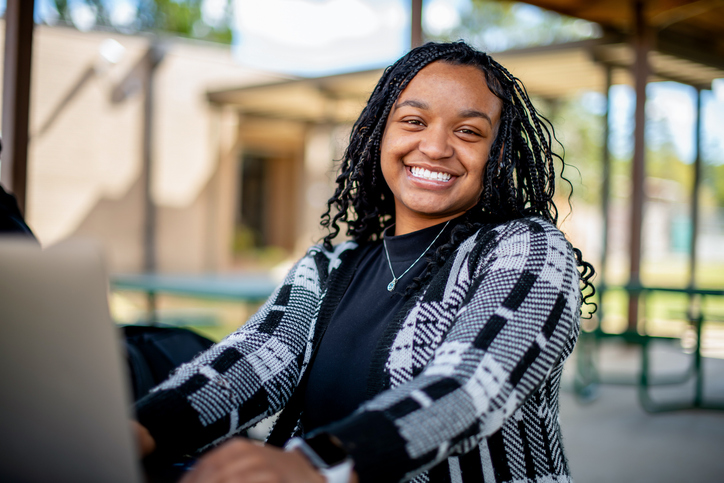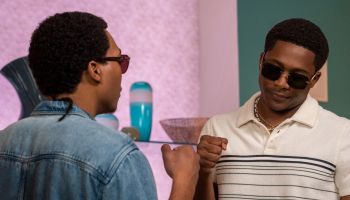It’s rare to find someone, anyone, who can keep up with the world famous Jamaican Olympian, Usain Bolt, both on the track and off the track — after all, his name is synonymous with speed.
That is where Karen Fuchs comes in. No, she isn’t a track runner, but she is familiar with the importance of shutter speed when it comes to documenting the fastest man in the world.
PHOTOS: From “Survivor” To Jewelry Designer, Sabrina Thompson Dishes On How She Does It All
Karen’s story begins long before Usain Bolt was one known internationally, when on a whim from a tip, she flew out to Jamaica to document the journey of this incredible 17-year-old runner. Unbeknownst to her, this would be the move that would change her life.
During her wildly successful 20-year career as a photographer, the biggest, and most personal project was her documentation of Usain.
PHOTOS: Salvatore Ferragamo Steps Into The Olympic Circle For Republic Of San Marino’s Olympic Team
Now, with the London Olympics on the brink of kickoff, Karen is ready to share one of her life projects with the public with the exhibit titled “UNSCRIPTED – Early Photographs of Usain Bolt.”
GlobalGrind had the absolute pleasure of speaking with the charismatic photographer about her project that opens up July 25th and runs through August 13th, 2012.
Check out the exclusive interview below and a preview of photos from the exhibit in the gallery above:
GlobalGrind: We know you’ve been a photographer for 20 years now, but let’s go back and get the back-story of how you got started.
Karen Fuchs: My grandmother was the first female stage designer in Germany, so I grew up with a lot of fine art around me, and she taught me how to paint, and originally I wanted to become an artist, and I studied fine art and for one project, I had to do some photographic research and was scared of the technical aspect of it. But my teacher sat me down, explained the camera to me and after 3 days in the field when I came back, he just looked at the result and said, “You better change subjects.” And the rest is history. So I never completed my fine arts painting sculpture degree, but switched to photography and after I left college, I assisted in London and was lucky to assist some very good photographers and then went freelance in 1992. I’ve never been employed a single day in my life.
That is amazing!
I’ve never even written a CV, I’m totally unemployable. Someone asked me once, ‘Are you married?’ and was in my 20s then and I instinctively said, ‘Yes, to photography.” And it was self-fulfilling prophecy and it’s kind of for better or worse. But I’m lucky that I found my passion and I think that’s so much easier.
Once you find your passion, you just go for it, it’s not always easy but in a way you don’t have your choice, that’s a calling.
Aside from your shots of Usain, but you have a lot of shots with Jamaica as your background. What do you find so compelling about the island as a backdrop for your photography?
I came to Jamaica for the first time because somebody had pointed Usain out to me when he was 17. And my first time in Jamaica, I was invited to go along to the biggest sports event there. It’s called High School Champs, where all the high schools from all over Jamaica come to Kingston and the whole island fills the stadium. The bleachers are just one big party with all the colors and the school bands. It is so vibrant but on the track, it’s a matter of life and death. You don’t see any smiles on the track, for a lot of kids, track and field is the only shot at a better life and that just really captured me.
Quite often there is a spark, and I learn and I gain experience from what they do and it infects me and that’s something I really picked up in Jamaica as well. There’s such a hunger for the kids to better their life; with Jamaicans, they’re very passionate and proud people, you know exactly where you stand. I’m German, so I get along with the direct type, let’s put it that way.
What was most compelling to you about the Jamaican Juniors shoot?
I think if you grow up in pretty much any of the western countries, you’re already privileged. You have a head start in life. In a lot of aspects in Jamaica, there are areas where it’s almost third world, and the choices are limited. A lot of the kids understand that athletics offers them a chance at a better education for scholarship in the states and tying this exhibition in with charity, if one child over there ends up getting a better shot at life then I’m happy and I want to give back with this exhibition because I fell in love with the island and I’ve met so many people who’ve become friends along the way. It’d just be really nice to give back for all the time they’ve spent looking after me and showing me and teaching me things and that’s part of the idea behind it.
Have you ever seen photographs that embodied the same emotion as yours when it comes to capturing the Jamaican people in their athletics? Have you ever seen this story told before?
As a whole body of work, I don’t think I’ve seen it anywhere else yet.
You’ve been shooting Usain since he was 17. He is now known globally. What about his star power when you’re following him around in Jamaica, what is that like?
He has a huge fan base over there, he’s a hero over there now. In the beginning, it was never a problem, but the last few years there’s always a ton of people coming up and ask for autographs, especially the kids. The kids really love him and he lets them close. He now has a couple of people that walk with him, but even when the fans come up to him, I haven’t seen a difficult situation. They’re still very respectful and the fact that he stayed, he remained local and didn’t move to America or somewhere else and he stayed in Kingston, I think people give him a lot of respect for that.
You started shooting him clearly before he was as famous as he is today. What exactly about him intrigued you about his personality, besides his athletics, what about him as a person intrigued you to be working with him for this long?
He’s very charismatic. He’s always up for a laugh. In the early years, I used to say that he was a total goofball, it was almost impossible to get a serious picture with him, he was always up to joke, but now he’s become much more experienced in front of the camera. Over the course of years working with him, I’m actually the only photographer that captured him in early years and there’s a whole bunch of TV stations all over the world now that have been purchasing some of the images to include in documentaries about him, because there’s no other photographer that has those shots.
I was lucky that I followed someone’s tip and I started shooting him out of my own accord in the beginning and it just paid off. He’s a very warm person. I’ve worked with him in situations where there’s a whole press pack, and I just say “Usain” and he hears my voice in that whole pack and just connects with my camera. I’ve been in other situations. Coach Mills, his coach, is a fairly strict person and obviously he needs to be as well and quite often nobody is allowed on the track, but because I’ve been around for such a quite long time and I’m always very respectful of the situation.
So you’ve been following him, documenting his life and his fame. How did it change your life following him?
I fell in love with Jamaica. I love going to the island now. I’ve just suddenly realized beginning of this year when I started putting things together, its probably the single biggest body of work that I’ve created on one subject. One of Usain Bolt and one of the high school champs and it’s a tremendous body of work and it’s been incredibly difficult to narrow it down to the images that are in the exhibition and I hope that there will more opportunity to show more of the work in the future because whenever I’ve shown those images to people, the ones of Usain, they started smiling or laughing and saying, ‘Wow, you’re in a different light now,’ and I love to share that because I’ve been lucky to see that person outside of him and I think he’s a great guy.
I know he got criticized, particularly here in the States as well, that he’s goofing around and doing his little dance and that it was all a show, but it’s not a show, that’s him.
He has that natural confidence as well, which I think makes him so successful because, especially as a track and field athlete. If you don’t have that confidence, you’re not going to win because you have to deliver on a hundredth of a second.
So when you’re curating your photos for Unscripted, was that what you were going off of? Showing his true playful nature or more of his serious side?
I showed both. Some of the hard work on the track, there’s a couple of shots which I included as well, which I think are a very personal because they show a very vulnerable side of him, and then definitely the fun ones, the laughing around ones where he’s up to playing tricks.
What’s the most important lesson that you’ve learned shooting Usain is his native that you want people to know about?
Go after your dreams, because I think it’s that story with hard work and passion and determination. You can create the life that you want.
Be sure to check out “UNSCRIPTED – Early Photographs of Usain Bolt” on Facebook, and follow Karen on Twitter for updates on the show, Usain, and her wonderful photography journey.
















